Aeroponic Weed Growing: Everything You Need to Know
- What is Aeroponics?
- The Anatomy of Aeroponic Systems
- How to Grow Weed in Aeroponic Setups: A Step-by-Step Guide
- Tips for Growing Marijuana With Hydroponics
- Pros of Aeroponic Weed Growing
- Cons of Aeroponic Weed Growing
- Aeroponics vs. Hydroponics: Which One’s Better?
- Which Genetics to Choose for Your Aeroponic Weed Grow
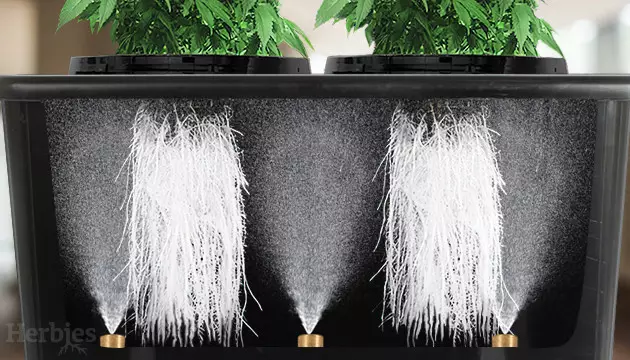
If you already have a few successful soil or hydro grows under your belt, why not experiment with a more sophisticated aeroponic weed grow? While it’s definitely not for newbies, this method may surprise an experienced and dedicated grower with record-breaking yields and a fast turnover. Read on to find out how aeroponics for weed works.
What is Aeroponics?
Aeroponics is a method of growing crops indoors with the roots of a plant hanging freely in the air inside a darkened chamber while a high-pressure misting system delivers water and nutrients directly to them in the form of tiny droplets. Since the roots can constantly drink, eat, and breathe at the same time, an aquaponics setup ensures superior growth rates even compared to hydroponics.
The Anatomy of Aeroponic Systems
There are two main types of aeroponics setups: a more professional one with a separate reservoir for the nutrient solution and a simpler, amateur contraption where the solution is stored on the bottom of the same chamber where the roots are dangling. In the former system, the roots never come in direct contact with water. In the latter, the roots reach the bottom of the reservoir sooner rather than later, and their ends float in water (making it a hybrid between aeroponics and DWC).
No matter the type, an immersion pump delivers the nutrient solution from the reservoir to the roots through a system of sprinklers or high-pressure misters that are strategically placed around the root ball. The pump doesn’t work all the time – an interval timer repeatedly turns it on and off (e.g. 1 minute on and 4 minutes off). High-pressure misters can create a very fine but dense fog in mere seconds, followed by a 4-minute off period.
The stems of the plants are secured in the lid of the chamber with a foam collar inserted in a net pot (of the kind used in hydroponics). There are many turnkey solutions for aeroponics available on the market, and even those that were designed to grow culinary herbs are used by aeroponics cannabis growers, usually for cloning but sometimes for small seed-to-harvest grows too. DIY-minded gardeners can easily fashion a homemade aeroponics system out of a large opaque plastic tub using a pump, some PVC piping, sprinkler heads, and a timer.
How to Grow Weed in Aeroponic Setups: A Step-by-Step Guide
Step 1. Buy or Construct an Aeroponics System
It’s best to buy an aeroponics system specifically designed for weed cultivation, as kits for other crops may be too difficult to adapt for cannabis. After all, our favorite plant is very unlike leafy greens in size, the amount of light it requires, and other conditions.
Step 2. Choose the Right Light
Make sure your light runs cold enough – otherwise, the radiation heat may make it too hot in the root zone. Generally, you don’t want to go outside the 65-75°F (18-24°C) temperature range. For this reason, old-fashioned hot-running HID lights are out of the question, so it’s best to choose an LED. It’s easy to warm the nutrient solution if needed, but chillers are very expensive.
Step 3. Prepare a Nutrient Solution
If the roots and the water in your setup are in the same tub, make sure it’s opaque and light-proof so that there’s no algae clogging your pipes and competing with the plants for nutrients. The same goes for an external reservoir and the pipes leading to it.
Buy organic or synthetic nutrients suitable for hydroponics (both for the veg and flowering stages), carefully read the manufacturer’s instructions, and don’t exceed the recommended dosages. It’s best to start with a quarter of what’s recommended – the worst thing that can happen is that your plants will go a little hungry – and gradually work your way up.
Step 4. Try Out the Misters and Timer
Start with a standard 1-4-minute schedule and make sure everything works. You can adjust the schedule later as you go.
Step 5. Put in Your Seedling or Clones
People usually start clones in rock wool plugs. After a while, the roots emerge from the plug, and this means they are mature enough to be put into aeroponics. Secure the plug in the net pot (in the lid of the tub) with a tight-fitting foam insert (collar). Don’t forget to cover the net pot with an opaque cap with only a hole for the stem.
When growing marijuana from seeds, people seldom plant seedlings in rock wool plugs, but it’s a working method, and we suggest using it for aeroponics. Alternatively, you can use jiffy plugs.
Tips for Growing Marijuana With Hydroponics
Naturally, an aeroponic system for weed isn’t a ‘fire-and-forget’ kind of thing. You’ll need to monitor it constantly. Here are a few tips.
Protect the Root Zone From Light
The tub, reservoir, and pipes should all be made of dark, non-transparent material to prevent the growth of algae inside the system. Don’t open it unless necessary and put a cap over each net pot or vacant place.
Check Your EC Levels
Soil growers can get away with not using a TDS meter, but it’s a must in coco, hydro, and aeroponics. Learn the maximum EC levels for each stage in the plant’s life cycle and never exceed them.
Get the pH Right
Whenever you use synthetic fertilizers, you should monitor the pH, as nutrients get absorbed only at specific levels. Generally, readings anywhere between 5.5 and 6.0 are okay, and you can let them fluctuate a bit within this range to facilitate the absorption of different nutes.
Keep the Temps in Check
Many growers know that there is a temperature range that’s ideal for cannabis at different stages, but few realize that it’s the temperature of the root zone that’s the most important. The above-ground part can take a lot of cold or heat if only the roots sit at a comfortable 65-75°F (18-24°C).
Keep an Eye on Water Levels
Keeping your system sealed and having caps over the net pots goes a long way to preventing evaporation, but it will happen anyway. The danger here is that the H2O evaporates but the salts remain and the concentration of the solution increases.
Watch Out for Clogging
One of the risks of aeroponics weed cultivation is that the pipes and nozzles can clog, so thoroughly wash everything between cycles and make sure you only buy fertilizers that are compatible with hydroponics and automatic irrigation (some organic products are known to cause clogging).
Pros of Aeroponic Weed Growing
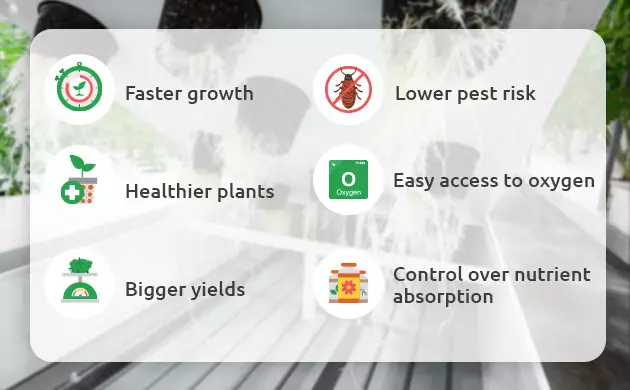
- Faster growth rates. Aeroponics apply nutrients dissolved in water directly to cannabis roots while allowing them to breathe freely at the same time. Fed constantly and never deprived of oxygen, plants grow much faster than in soil and even faster than in hydroponics.
- Higher yields. It’s the same as with faster growth – the plants get oxygen, water, and nutrients 24/7, with nothing distracting them from the business of stacking up huge and dense buds.
- Lower risk of pest attacks. Pests, such as fungus gnats, can proliferate in the root zone of a plant grown in soil but not in aeroponics. Additionally, if you put a cap over the net pot as light protection, it’ll also serve to keep pests at bay.
- Less water wasted. Aeroponics is a closed-loop system and thus much more economical than any drain-to-waste system. You’ll still need to change the nutrient solution every 5-10 days, but this is not as much as the 20% that you lose as runoff with each watering.
Cons of Aeroponic Weed Growing
- Steep learning curve. You need to know cannabis intimately, as it’ll be up to you to feed your weed plants with everything they need down to the least important micronutrient. You’ll also need to detect problems early on, as any deficiencies will manifest and take a turn for the worse almost immediately.
- Dependence on equipment. Be sure you’re technically inclined and have no problems constantly checking all those pumps, tubes, and nozzles and repairing them as needed. If any of them fails or gets clogged, the roots will start to dry out.
- Power outages are fatal. With lights, fans, and heaters at work, power outages are no fun in any indoor grow, but in aquaponics setups, they kill your plants in no time due to the simple fact that cannabis roots can’t survive just hanging in the air.
- Less complex flavor of smoke. Compared to buds grown in soil, especially organic soil, the flavor profile of aeroponically-grown smoke is less nuanced.
Aeroponics vs. Hydroponics: Which One’s Better?
If you don’t mind constantly hovering over your plants, cannabis aeroponics cultivation is very rewarding compared with hydroponics. It creates a bigger root system with a greater number of fine roots, resulting in larger and heavier harvests. However, be prepared for more things to potentially go wrong, calling for a more hands-on growing style.
Which Genetics to Choose for Your Aeroponic Weed Grow
The best aeroponics cannabis seems to be Indica, as this cultivation method results in ridiculously fast vegetative growth, and things can get out of control pretty fast if you pick a tall Sativa. Also, avoid bushy strains if you plan to grow many plants next to each other SOG-style. Autoflowering strains are perfect for aeroponics since their veg time is short and ends automatically, before they grow too tall for your indoor setup.
Final Thoughts on Choosing Aeroponics for Weed Growing
Aeroponic weed growing isn’t the easiest cultivation method, but it’s nothing that a dedicated hobbyist can’t master. Just don’t choose it for your first grow, or else you may find yourself overwhelmed with technical issues while your main focus should be on getting to know the cannabis plant itself. Later, when you’re intimately acquainted with its botany and growing patterns, go ahead and try your hand at aeroponics – it will bring you the biggest harvest you can ever hope to get indoors.
Herbies Head Shop expressly refuses to support the use, production, or supply of illegal substances. For more details read our Legal Disclaimer.






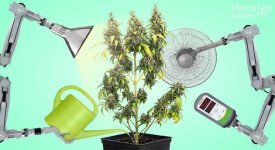







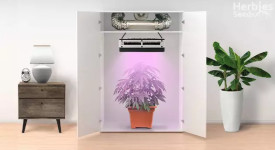
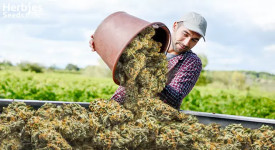

Thank you for leaving a comment for us!
Your feedback will be posted shortly after our moderator checks it.
Please note that we don’t publish reviews that: